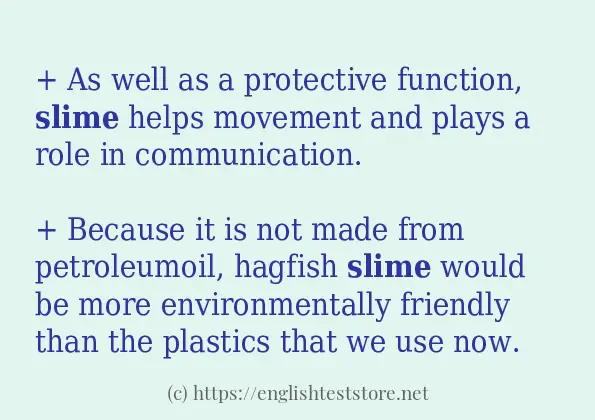How to use in-sentence of “slime”:
+ As well as a protective function, slime helps movement and plays a role in communication.
+ Because it is not made from petroleumoil, hagfish slime would be more environmentally friendly than the plastics that we use now.
+ Slime moulds, or slime molds, are forms of life which live on the rainforest floor, and many other parts of the world.
+ There is good reason to think the slime is produced by the algae to control the way their carbonate skeletons are formed.
+ The segmented worm-like organisms have tiny eyes, “fur”, antennae, multiple pairs of legs, and, slime glands.
+ This slime comes out of the sides of the hagfish’s body.
+ Nickelodeon became known for its iconic green slime that was originally used in this show.
+ James Christian “Jimmy” Hibbert is an English peopleEnglish Cosgrove Hall, mainly voicing Dr Von Goosewing, Ruffles, Gaston and many other characters in “Victor Hugo”, Bluey, Harry Slime and Bella in “Avenger Penguins” and Big Ears, Mr Plod, Mr Sparks, Mr Milko, Clockwork Clown, Gobbo and various male characters in “Noddy’s Toyland Adventures”.”Manchester Evening News”.

Example sentences of “slime”:
+ They are able to make enough slime to completely fill a two-gallon bucket.
+ In slime moulds, these structures are called spores, and form on stalked structures called fruiting bodies or sporangia.
+ Similar life cycles have developed among the amoebae called cellular slime moulds.
+ The reason such a small fish can make so much slime is because the slime comes out in strings that quickly swell up much bigger when they are in the water.Their unusual way of eating and their slime has made many people call the hagfish the most “disgusting” of all sea creatures.
+ They scatter spores, like plants, which grow into new slime moulds.
+ Modern molecular biology has shown by sequence analysis that slime moulds are not a monophyletic group.
+ Some Chromalveolata, some fungi and some slime moulds have what seems to be genuine alternation of generations.
+ Scientists are studying hagfish slime to see if they can use it to make things.
+ This type of movement is observed in amoebae, slime molds and some other protozoans such as “Naegleria gruberi”, as well as some cells in humans such as white blood cells.
+ There is good reason to think the slime is produced by microorganisms to control the way their carbonate skeletons are formed.
+ There are organisms which change from single cells to whole organisms: for example, slime moulds.
+ They are able to make enough slime to completely fill a two-gallon bucket.
+ In slime moulds, these structures are called spores, and form on stalked structures called fruiting bodies or sporangia.
+ A green slime will appear around it, and hydrogen will be released at the cathode.
+ The strings of protein in hagfish slime are thin and strong, so they are a useful material.
+ There are three groups, which have evolved slime mould form independently.
+ They are close relatives of the slime moulds.
+ However, flagella occur among some archamoebae, and many slime moulds produce biflagellate gametes.
+ The Amoebozoa also include the Mycetozoamycetozoan slime moulds, multinucleate or multicellular forms which produce spores and are usually visible to the unaided eye.
+ Once the specimen is physically irritated or touched by another creature, it will release the slime automatically.
+ Fake blood, toy slime and gunge all get their thickness from xanthan gum.
+ The scales are usually covered with a layer of slime which improves passage through the water, and makes the fish more slippery to a predator.
